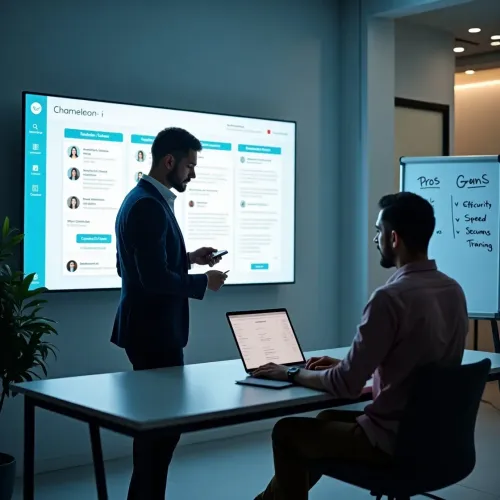Should You Grant the Hiring Manager Access to Your ATS?

Applicant Tracking Systems (ATS) have become the backbone of modern recruitment — helping agencies manage candidates faster, smarter, and more efficiently.
But there’s a common question a lot of agencies wrestle with:
Should you give your clients (the hiring managers) direct access to your ATS?
The short answer?
It depends — and there are real pros and cons to think about.
Let’s walk through them.
The Upside: Why You Might Say "Yes"
1. Faster, Smoother Communication
When clients have access to your ATS (like through Chameleon-i), they can:
View candidate profiles instantly
Leave feedback without endless email chains
Move to interviews or offers faster
It cuts out the back-and-forth — and that means faster hires.
2. Speeding Up Decisions
Good candidates don't sit around forever.
When hiring managers can log in, review shortlists, and move fast, you stand a better chance of landing the best talent before someone else does.
Chameleon-i even lets clients collaborate inside the system — scheduling interviews, approving candidates, and keeping momentum high.
3. Aligning Hiring Goals
Giving clients visibility into your candidate pipelines can help align everyone’s expectations early.
They get a clear sense of the market, timelines, and available talent — which means fewer last-minute surprises or unrealistic demands later.
4. Stronger Partnerships
Opening up access signals trust.
It shows clients you’re not hiding anything — and that you’re serious about working as a true partner, not just a vendor.
When managed well, it can really strengthen the relationship.
The Downside: Risks You Need to Manage
1. Data Security Worries
Candidate data is sensitive — and once you open the door, you have to make sure it's protected.
Luckily, with a platform like Chameleon-i, you control exactly what each client can see.
Granular permissions, strong encryption, and full audit trails keep you (and your candidates) safe.
2. Introducing Bias Risks
Sometimes too much client access can lead to issues — like unconscious bias creeping into early candidate reviews.
That’s why smart ATS systems like Chameleon-i offer blind review options — hiding names, photos, or personal details during early screening to keep things fair.
3. Client Training Takes Time
You can’t just hand over login details and expect magic to happen.
Clients will need a bit of onboarding to understand how to use the system properly — but with Chameleon-i’s intuitive dashboard and support resources, it’s easier than you might think.
(And a little training up front saves a lot of headaches later.)
4. Clients Aren’t Recruiters
Even with great tools, clients won’t always "read" a candidate profile the way an experienced recruiter would.
Your role stays essential — interpreting CVs, reading between the lines, and advising them on the right choices.
An ATS is a tool — not a replacement for your expertise.
How Chameleon-i Makes Client Access Smarter (and Safer)
If you’re thinking about offering ATS access, Chameleon-i gives you the right controls to do it on your terms:
Advanced Security: Set specific access levels for different clients and keep full control over candidate data visibility.
Bias Reduction: Enable anonymized CV reviews to support fair hiring decisions.
Easy Training: Provide simple, effective training materials so clients can use the system without hand-holding.
User-Friendly Interface: Make it easy for even non-technical clients to navigate, review, and collaborate.
You stay in charge — while making the client experience better.
Final Thoughts: Should You Share Access?
Giving clients direct access to your ATS can absolutely make collaboration faster, smoother, and smarter —
as long as you manage it well.
With strong security, smart client training, and the right balance of transparency and control (all of which Chameleon-i supports), it’s a smart move that can strengthen relationships and improve results.
The key?
Use the technology to enable better partnerships, not to replace your expertise.
Because at the end of the day, recruitment is still about people — not just platforms.